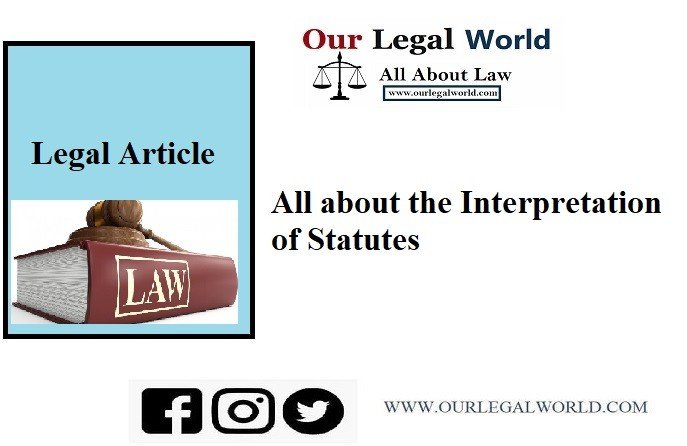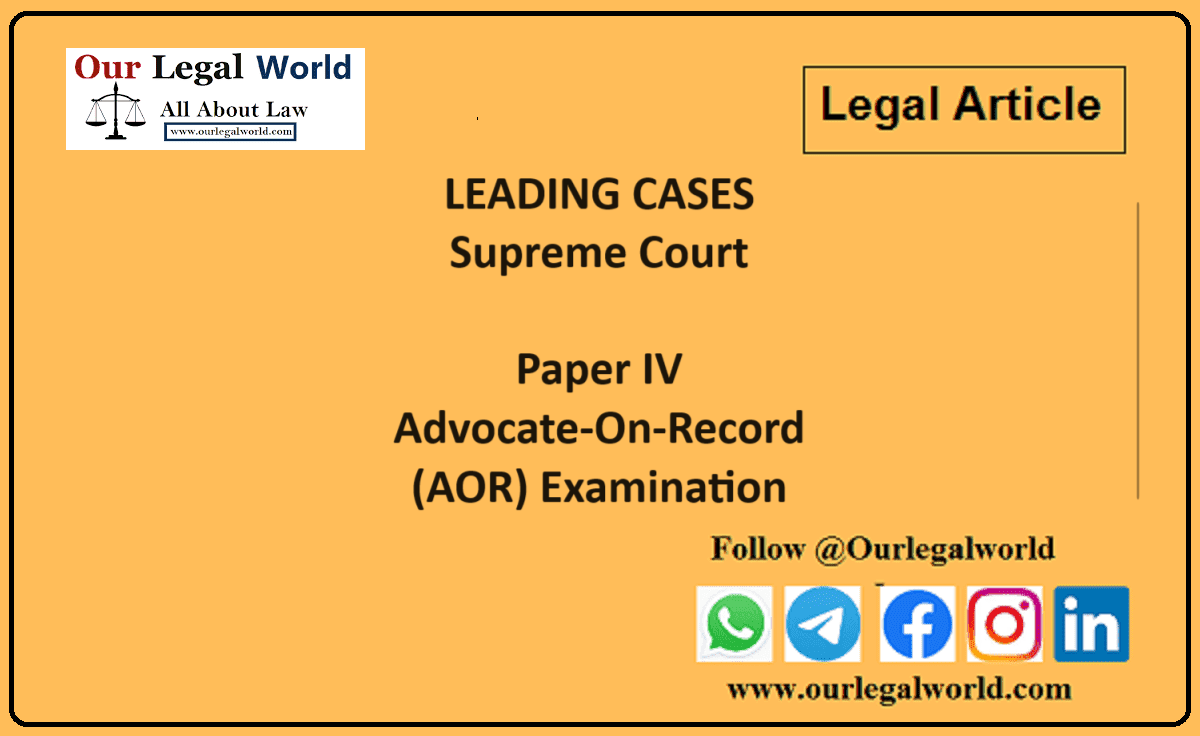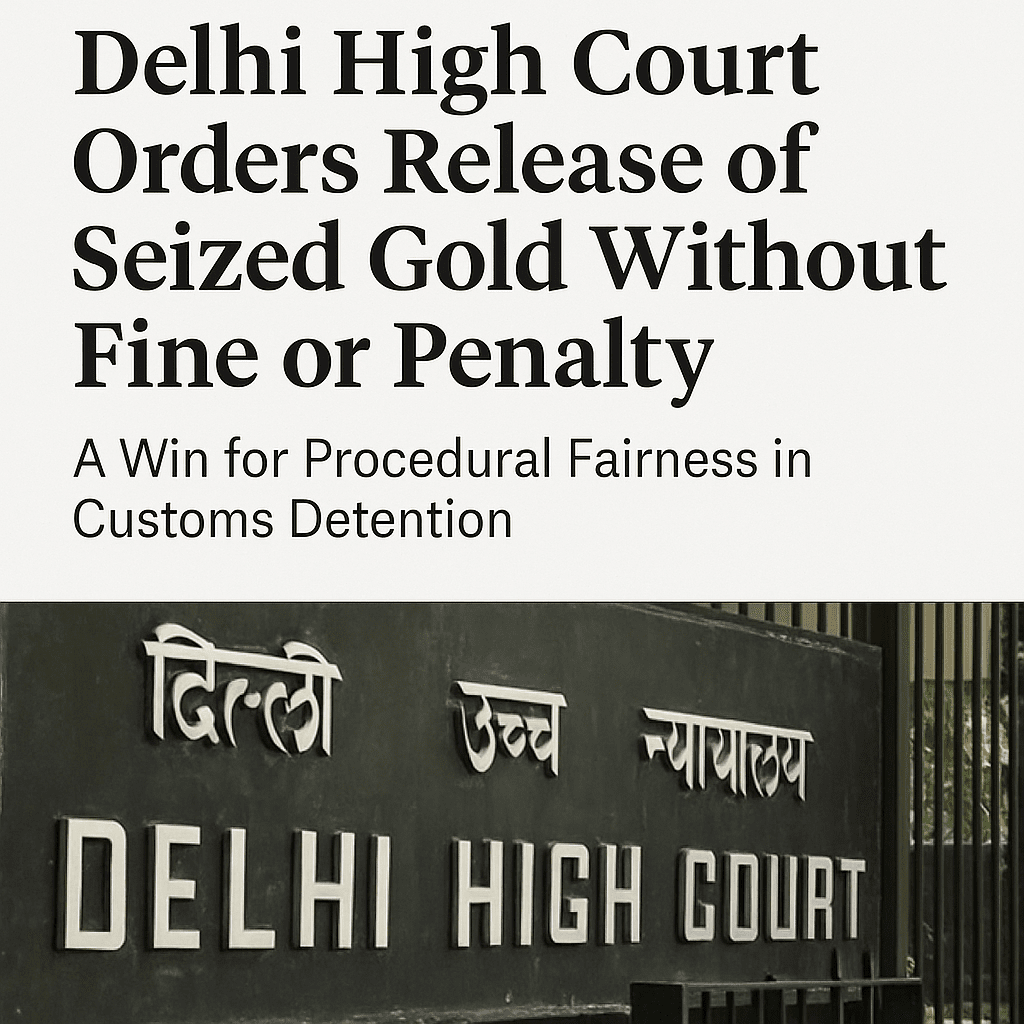All About Interpretation of Statutes
A statute is a particular declaration of the law on a certain issue. A statute, or statutory law, is a law that has been sanctioned by a governing body, which is the body that has been acknowledged the power by a constitution to represent legislation, or laws.
Interpretation means the art of putting forward the true meaning of the given words and be enacted as their natural and usual understanding. The Court is not expected to illuminate readily and therefore there are certain principles which have emerged out of the prolonged exercise by the Courts.
Salmond has given a definition for interpretation of Statutes as,
“Interpretation or construction is the process by which the courts seek to ascertain the meaning of legislation through the medium of the authoritative form in which it is expressed.”
What is statutory Interpretation?
Statutory Interpretation is the action through which the courts apply and interpret the legislation as some sum of Interpretation is necessary when there is a statute in a case. Justice G.P Singh marked the importance of interpretation of statutes. To elaborate the meaning of statutes the Judges various techniques and methods of statutory Interpretation which indulges legislation history, earlier or traditional statute Interpretation etc. Interpretation of statutes is necessary as to determine the right meaning of the words in the statutes.
Statutes
The statutes should be read whole as a context and must be build-up very productive and practicable. The process of structuring should be authentic as well as persistent which features that one should shift from literal construction as it leads to absurdity.
Types of Statutes on the basis of Duration
1. Perpetual statutes
It a type of statute in which there is no duration for the statute unless the statute is abrogated.
2. Temporary Statute
It is a kind of statute that is there for a very short period of time and after the required time it expires.
Classification of statutes on the basis of nature of operation
1) Prospective effect
This type of statute would be in effect once notification for the such is being done.
2) Retrospective effect
This statute is in effect since previous periods that is it has been there for longer span of time.
3) Directory statute
A directory statute is one where disobedience will not abrogate the proceedings to which it relates.
4) Mandatory Statute
A Mandatory statute is a type of statute whose provisions or requirements, if not abridged with, will construe the proceedings to which it relates illegal and void.
Classification on the basis of reference to objective
A. Enabling Statute
Enabling Statute is a type of statute which permits something to be done. It primarily provides the power to do something and makes something lawful to do which could earlier not be regarded as lawful.
B. Penal Statute
A penal statute is kind of statute which makes certain acts or wrongs punishable. This kind of statute may be in the mode of a broad criminal code or enormous number of sections providing punishment for different wrongs for example in India we have, Criminal Procedure Code, Indian Penal Code etc. The penalty for revocation may be in the mode of fine, relinquishment of the property, imprisonment, death sentence and much more.
C. Taxing Statute
In this type of statute through which a tax is imposed for the public purpose for generating the general revenue of the state. This statute is to be strictly defined.
D. Codifying Statute
This is a type of statute which presents an explained authentic statement of the rules of law on a given subject. The aim of this statute is not merely to declare the law upon some particular subject but to declare it in the form of codes.
E. Amendment Statute
We are well known that “Amendment” means a change an existing law. Any law is amended when it is in whole or in part, permitted to remain and some part is added to or taken away from it or it is in some way changed or altered to make it more complete or perfect or make it suitable to attain the purpose for which it was amended.
F. Repelling Statute
Repealing Statute is a kind of statute which repeals any existing statute.
G. Consolidating statute
It is a kind of statute which encloses and conjoins all the law on a particular subject at one place which was dispersed and spread out at different places.
Some statutes are:
- Constitution
- State acts
- Central acts
- By laws
- Rules
- Regulations
- Ordinance
Rules of Interpretation
Literal or Grammatical Rule
This is the first rule of interpretation. As per this rule, the words used in any text are to be given or interpreted in their natural or ordinary meaning. After the interpretation, if the meaning of the text is completely clear and obvious then the effect shall be given to a provision of a statute aside from what may be the consequences. The basic rule is that whatever intention the government had while making any provision it has been expressed through such text and thus, are to be interpreted in accordance to the regulations provided in the grammar. It is the most secure rule of interpretation of statutes as the intention of the government is analysed from the words and the language used in the text. As per this rule, the only duty of the court is to give effect if the language of the statute is simple and has no function to look into the consequences which could arise later.
The only understanding of the court is to clarify the law as it is and if any hard consequences arise then the relief for the same shall be hunted and looked out by the government. In the supreme court case of Manmohan Das the case was registered in view of the interpretation of section 3(1)(c) of U.P Control of Rent and Eviction Act, 1947. As per this case, a renter was liable for evidence if he has made any addition and surrogate in the building without proper authority and unauthorized approach as materially altered the settlement or is likely to depreciate its value. The appellant certained that only the constitution can be covered, which diminishes the value of the property and the word ‘or’ should be read as land. It was held that according to the rule of literal interpretation, the word ‘or’ should be given the meaning that a cautious man understands the grounds of the event are alternative and not combined.
The Mischief Rule
The Mischief Rule was created in Heydon’s case in 1584. This is the rule of purposive construction because the purpose of this statute is most important while practicing this rule. It is called as mischief rule because the focus of this rule with hold the mischief. In the Heydon’s case, it was held that there are four things which have to be followed for real and sure interpretation of all the statutes in general, which are:
1. What was the usual law before the making of an act.
2. What was the mischief for which the present statute was executed.
3. What remedy did the Parliament needed or had resolved and appointed to treat the disease of the republic.
4. The right reason of the remedy.
The ambition of this rule is to decrease the mischief and progress the remedy.
In the case, Pyare Lal Vs. Ram Chandra, the accused was prosecuted for selling the sweeten “Supari” which was sweetened with the help of an artificial sweetener. He was prosecuted under the “Food Adulteration Act.” It was confronted by Pyare Lal that supari is not a food item. The court held that the meaning provided in the dictionary is not always the correct meaning, therefore, the mischief rule must be applicable, and the interpretation which processes the remedy shall be taken into scrutiny. Therefore, the court held that the word ‘food’ is utilisable by mouth and orally. The prosecution was held valid on the mentioned grounds.
The Golden Rule
This rule is the adaption of the principle of grammatical interpretation. As per this rule, commonly the words used in the statute should be given their ordinary meaning but if it leads to inconvenience, hardship or injustice, the courts must revise the meaning to such an extent so as to remove such inconvenience or injustice. As this rule solves all problems that is why this rule is known as Golden Rule. This rule is based on the belief that the government does not intend certain objects and any development leading to any of such objects deserves to be rejected.
In the case of supreme court of Quiser Jehan Begum [2], a time duration was recommended under section 18 of land acquisition act, 1844, that there shall be an appeal filed for the broadcasting of the award within 6 months of the announcement of the compensation. Award was given to Quiser Jehan. It was asserted to her after the period of six months about this by her counsel. The appeal was filed ahead the period of six months. The appeal that was filed was dismissed by the lower court. It was held by the court that the period of six months shall be counted from the time when Quiser Jehan had the knowledge because the interpretation was leading to idiocy. In this case the court used the golden rule for allowing the appeal.
HARMONIOUS CONSTRUCTION
As per this rule of interpretation, when two or more provisions of the same statute are adverse to each other, then in such a situation the court, if possible, will try to define the provisions in such a manner as to give effect to both the provisions by maintaining consistency between the two. There can arise a question that there can be 2 provisions of a statute that could be overlying or mutually segregated it may be difficult to determine the same.
The government analyses its intention through the words used in the provision of the statute. So, here the basic principle of harmonious construction is that the government can not have tried to contradict itself. It can be assumed that if the government has intended to give something by one, it would not intend to take it away with the other hand as both the provisions have been made by the government and captivated the equal force of law. It was important to note that one provision of any same act cannot make the other provision of the same act ineffectual. Thus, in no circumstances, the government be expected to counter it’s own self.
In the case Ishwari Khaitan Sugar Mills v. State of Uttar Pradesh, the State Government proposed to acquire sugar industries under U.P Sugar Undertakings (Acquisition) Act, 1971. This was challenged on the ground that these sugar industries were declared to be a controlled by the union under Industries (Development and Regulation) Act, 1951, and accordingly, the state did not have the power of attainment of seizure of property which was under the control of the union. The Supreme Court held that the power of acquisition or attainment was not occupied by Industries (Development and Regulation) Act, 1951. The state has separate power under provided to it.
Different aids of Interpretation of Statutes
• Internal aids: that are present within the statutes
Title
Heading
Preamble
Definitions
Schedules
Explanations
• External aids:
Historical experiences
Judicial judgments
Dictionary
Foreign Decisions
Conclusion
Each country has its own judicial system, the motive of which is to grant justice to all. The court aims to clarify the law in such a manner that every citizen is ensured justice. To ensure justice to all the concept of canons of interpretation was set forth. These are the rules which are derived for determination of the real intention of the government. It is not necessary that the words used in a statute are always clear, accurate and apparent and thus, in such cases it is very important for courts to determine a clear and accurate meaning of the words or phrases used by the government and at the same time remove all the doubts if any.
Reference
- Citation
[1] Bishan Das, SC 643 AIR 1967
[2] state of Punjab vs. AIR 1963 SC 1604 - https://blog.ipleaders.in/







![Tax Law Internship at Legum Attorney [Chamber of Ashish Panday], Delhi : Apply by 15th May 2025](https://www.ourlegalworld.com/wp-content/uploads/2025/05/IMG_0113-min.png)

